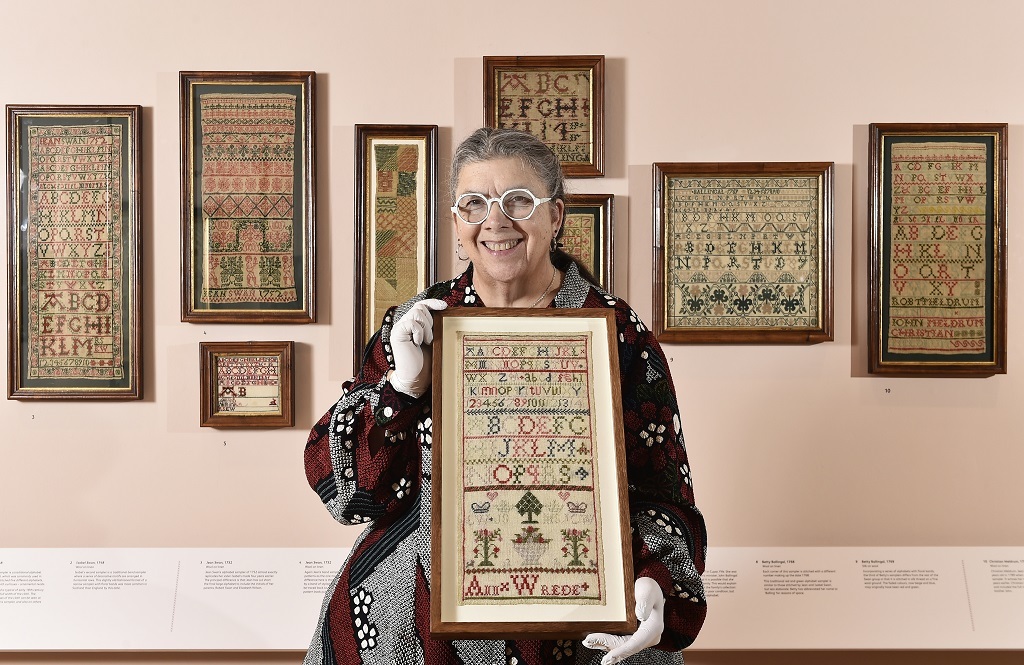
A stitch in time opens a door to Scotland’s past
An extraordinary collection of Scottish needlework from the 18th and 19th centuries is now on show.
The 70 samplers in the exhibition are on loan from American collector Leslie B Durst, a philanthropist and passionate supporter of the arts who has assembled a remarkable collection of samplers from Europe and North America.
They are on show from today, 26 October, until 21 April 2019 at the National Museum of Scotland, Chambers Street, Edinburgh.
The Leslie B Durst sampler collection is one of the largest and most comprehensive private collections in the world, and includes over 500 Scottish samplers, dating from the early 18th to the mid-19th century.
Leslie intends to bequeath this remarkable collection of Scottish samplers to National Museums Scotland.
Mostly made by young girls as part of their education, samplers were primarily a demonstration of sewing skills. Every sampler is both a study in needlework but, moreover, each one is a fascinating piece of social history and it is the stories stitched into the samplers that interest Leslie.
Leslie said: ‘I feel that giving each and every sampler maker the chance to tell their story again is my life’s calling. This exhibition gives me the opportunity to do so, and makes me very proud.’
Where possible Leslie undertakes extensive research into the background of the girls and their families. Using the initials, names and motifs that the children have stitched into their work Leslie has traced girls from all walks of life and from all over Scotland.
Exhibition curator Helen Wyld said: ‘This exhibition isn’t just about needlework: it is about the fabric of life in 18th and early 19th century Scotland.
‘Made by girls often from fairly modest backgrounds, samplers give us an alternative view of Scottish history, one that does not appear in the history books. They are therefore an invaluable and fascinating slice of Scottish social history.’
Samplers usually include the names of the girls who made them; and Scottish samplers in particular often show the initials of extended family members. These details have enabled Leslie to identify the girls through church and census records, and to conduct in-depth research into their lives.
This makes her collection a unique archive of Scottish social history from the early 18th to the mid-19th century, and a valuable glimpse into the lives of ordinary families.
By the 18th century, samplers were intended to demonstrate a girl’s education through the inclusion of alphabets, multiplication tables and religious verses, but they can also reveal other details of their makers’ lives. References to towns, buildings and events are common in Scottish samplers, giving a sense of what was important to the young girls stitching these pictures.

Leslie B Durst with Greenock’s Ann Wrede’s sampler dating from c1846 (Photo: Neil Hanna Photography)
The arms of the Flesher’s company appear in the sampler of Mary Hay, daughter of an Edinburgh flesher (butcher), while the now-ruined Dalquharran Castle in South Ayrshire appears in a sampler by Margaret Eiston.
Leslie’s research has revealed that Margaret’s father was a mason in Ayr and may have worked for the castle’s designer, Robert Adam. Jane Milton sewed hers while growing up in the Orphan Hospital of Edinburgh – in such institutions sewing was seen as a useful skill to equip girls with a means to earn a living.
The personal stories are perhaps the most touching. A sampler marked the attainment of skills and social graces, and sometimes recorded further milestones.
Anne Raffan’s sampler of 1789 shows her siblings’ baptism dates and, in 1792, aged 23, she added the date of her own marriage. A sampler begun by Jane Hannah of Garlieston has this touching addition by her friend: ‘the above lies sleeping in her grave; finished by Jane Murray’, and below the words ‘Time Flies; Death Reigns’.
Made by hand during their formative years, samplers record the things most dear to their young makers, and often these are the only records of lives that would otherwise be forgotten.
Exhibition officer Maureen Barrie added: ‘We are delighted to present this fascinating exhibition. Each story is different – some celebrate, others commemorate, many depict a sense of duty and care to family. Some are funny – comical cats stitched by little hands, and exotic zebras decorating Scottish landscapes.
‘From the Scottish Borders to the Western Isles no story is the same – we even have a sampler from a girl called Catharine McPherson, whose parents immigrated to America where she was born. At first glance it was assumed the sampler was from Scotland, but look closely at the ship in the corner of the sampler you will see an American flag.’
The samplers come from all over Scotland, with examples on show from the main cities but also from the Western Highlands to the Orkney Islands, and even an émigré Scots family in upstate New York.
The exhibition will be accompanied by a book and a programme of talks and events.
TAGS

